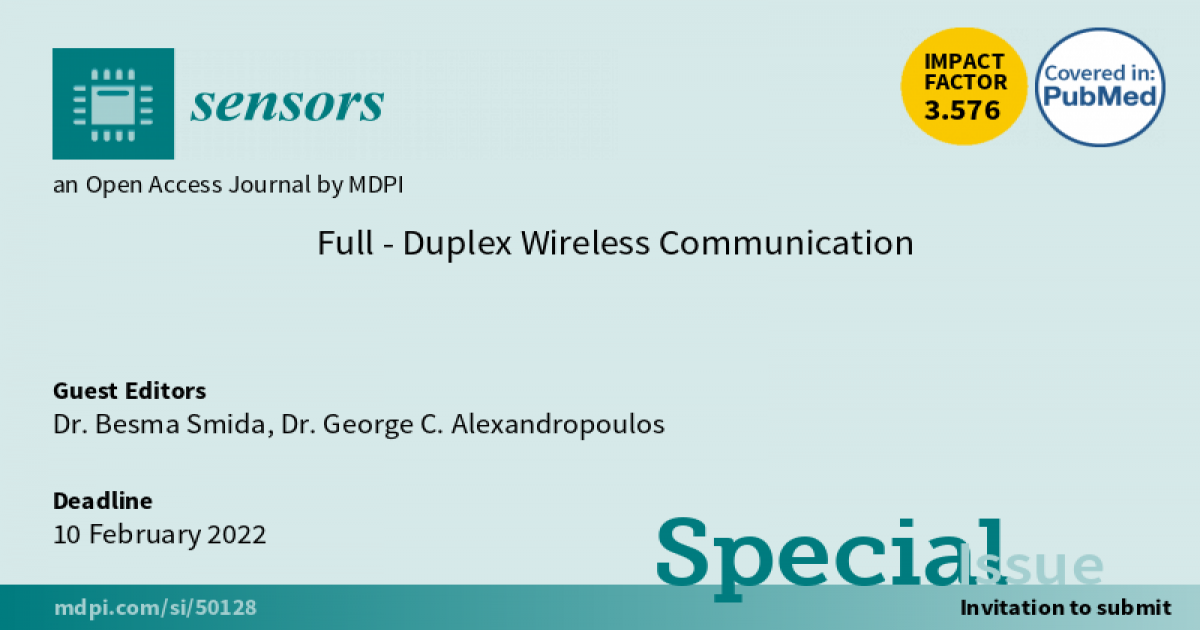Full-Duplex Wireless Communication
A special issue of Sensors (ISSN 1424-8220). This special issue belongs to the section "Communications".
Deadline for manuscript submissions: closed (10 February 2022) | Viewed by 8239

Special Issue Editors
Interests: wireless communication theory; full-duplex communication; Distributed sensor networks; Internet of things; radar; backscatter modulation
Interests: full-duplex systems; internet of things; (massive) millimeter-wave and THz systems; MIMO; physical layer security; reconfigurable intelligent surfaces; signal processing for communication; wireless transceiver architectures
Special Issues, Collections and Topics in MDPI journals
Special Issue Information
Dear Colleagues,
To meet the rising demand for high-speed data services, wireless networks must exploit the available frequency spectrum more efficiently. One key limit to spectrum utilization efficiency involves the current practice of half-duplex communication, in which a node either transmits or receives a signal in a single-channel usage. This separation prevents self-interference, which has frequently been seen as an insurmountable technical problem. Promoted by the popularity of small-cell wireless systems, recent works have provided experimental evidence and methodologies for full-duplex communication, in which a node transmits and receives signals at the same time and on the same frequency band. Full-duplex communications have the potential to improve the attainable spectral efficiency and throughput and reduce latency.
This Special Issue will provide a synthesized source of recent research results and to serve as a springboard for future work in Full-Duplex Wireless Communications. The possible topics include, but are not limited to the following:
- Advanced self-interference cancellation techniques for full-duplex
- Advanced antenna and transceiver designs for full-duplex
- Full-duplex reconfigurable intelligent (meta)surfaces
- Full-duplex techniques with wireless power and energy harvesting
- Full-duplex for simultaneous communication and sensing
- Full-duplex millimeter-wave/THz systems
- Multiple input multiple output full-duplex transceiver design
- Performance analysis of full-duplex transceivers, systems, and networks
- Physical layer security and full-duplex techniques
- Resource allocation and user scheduling in full-duplex networks
- Stochastic geometry for full-duplex systems
- Experimental evaluation of full-duplex transceivers and networks
Dr. Besma Smida
Prof. Dr. George C. Alexandropoulos
Guest Editors
Manuscript Submission Information
Manuscripts should be submitted online at www.mdpi.com by registering and logging in to this website. Once you are registered, click here to go to the submission form. Manuscripts can be submitted until the deadline. All submissions that pass pre-check are peer-reviewed. Accepted papers will be published continuously in the journal (as soon as accepted) and will be listed together on the special issue website. Research articles, review articles as well as short communications are invited. For planned papers, a title and short abstract (about 250 words) can be sent to the Editorial Office for assessment.
Submitted manuscripts should not have been published previously, nor be under consideration for publication elsewhere (except conference proceedings papers). All manuscripts are thoroughly refereed through a single-blind peer-review process. A guide for authors and other relevant information for submission of manuscripts is available on the Instructions for Authors page. Sensors is an international peer-reviewed open access semimonthly journal published by MDPI.
Please visit the Instructions for Authors page before submitting a manuscript. The Article Processing Charge (APC) for publication in this open access journal is 2600 CHF (Swiss Francs). Submitted papers should be well formatted and use good English. Authors may use MDPI's English editing service prior to publication or during author revisions.
Keywords
- self-interference cancellation techniques
- antenna and transceiver designs
- multiple-input multiple-output (MIMO)
- physical layer security
- full-duplex wireless power and energy harvesting
- experimental evaluation
Benefits of Publishing in a Special Issue
- Ease of navigation: Grouping papers by topic helps scholars navigate broad scope journals more efficiently.
- Greater discoverability: Special Issues support the reach and impact of scientific research. Articles in Special Issues are more discoverable and cited more frequently.
- Expansion of research network: Special Issues facilitate connections among authors, fostering scientific collaborations.
- External promotion: Articles in Special Issues are often promoted through the journal's social media, increasing their visibility.
- Reprint: MDPI Books provides the opportunity to republish successful Special Issues in book format, both online and in print.
Further information on MDPI's Special Issue policies can be found here.






